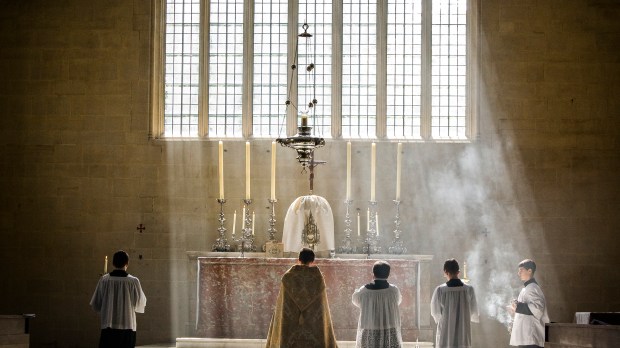A little-appreciated facet of the Catholic Church is the true diversity of Eucharistic liturgies available to Catholics, who are offered many forms and rites to meet their spiritual needs. In the coming weeks, Aleteia will feature pieces by Catholics writing on how and why a particular liturgy speaks most deeply to their spirit, and their worship. Here, Michael Morris shares with us why he loves the Extraordinary Form of the Mass.
I am the son of two converts to Catholicism. My father joined the Church in the early 1970s, and my mother was baptized and confirmed a few years after my own confirmation. For me, there have been three great moments in Catholic history: the Resurrection, Pentecost Sunday, and my father’s conversion. It was his conversion that set into motion who I am today. Thus, even more than the rest of my generation, I am a child of the post-Vatican II Church.
Living the faith with little familial history has meant forging my own path, learning about the Church through impulsive purchases at local bookstores and various book loans from a parish priest who had spent a great deal of his time in the hermitage.
The celebration of liturgy in the Church has always seemed to me remarkable. My weekly participation in Mass has been front and center in my life for some time, and I’ve often been in awe at the beauty that is Catholic worship.
However, I recently stumbled into a Mass that was being celebrated ad orientem — with the priest saying the prayers of the Mass facing the “liturgical east,” that is, facing an altar against the wall instead of the congregation. The Mass I attended, filled with Gregorian chant and incense, was celebrated in the extraordinary form (using the missal from before the Vatican II reforms) at Clear Creek Abbey in Oklahoma.
Before finding myself at this Mass, vernacular was a word I’d heard tossed around from time to time in reference to the liturgy, but for me Mass had always just been Mass. Hearing the Mass in Latin at Clear Creek was, however, not what struck me most. In fact, since my Latin did not hold up, I abandoned the missal with the vernacular translation, as I realized that trying to follow along was interfering with my ability to participate.
Since I didn’t understand the words being spoken, my focus turned instead to the visual markers, so as to recognize the progression of the liturgy. And thus came the moment that has lingered with me in a profound way. Like waking up early to catch the sunrise over a mountainous plain, I watched as the Body of Christ rose to prominence over the head of the celebrant. It was as though I had learned about the rubrics of Catholicism my entire life, but this was my first Mass attendance.
I was at the Abbey for a retreat on prayer, but I came home awestruck by the simple change of orientation in an act that I have seen in repetition over the course of 35 years.
Thomas Merton, a man considered one of the great spiritual writers of our time, was very passionate about the extraordinary form. He believed that his artist friends, who had no connection to the Church, would be scandalized at the idea of this liturgy being abandoned. His belief was that the Latin Mass and Gregorian chant were “masterpieces, which offer us an irreplaceable monastic and Christian experience.” When Merton wrote of his affection for the Latin rite he would use language such as beauty and art. He wrote as though he was standing in front of a Caravaggio or listening to Mozart.
This best explains how it captivated me. In the extraordinary form, my attention shifted from the words being said to the actions of the celebrant and the men surrounding him. By letting go of the need to understand each phrase, I was able to admire the beauty of the word flow. By letting go of the need to participate in the dialogue of the Mass, I was able to experience the miracle of the death and resurrection of our Savior. And by the celebrant leading his flock toward the East as the Son rose, I kneeled in awe at the beautiful artwork of Ecce Homo, Behold the Man.
Since that retreat experience, I’ve found a local liturgy celebrated in the extraordinary form. It is something of a guilty pleasure since I try to attend during the week, as time permits, when I am alone. (I recognize that for my wife and daughters, participating in the reformed liturgy is better.) The sights, sounds, and the reverence of the priests are nothing short of inspirational.
The Mass, in all forms, is a thing of beauty. I would have never been in the position to discover the extraordinary form had I not already loved the reformed liturgy. But there is undoubtedly a certain quality to the Latin rite. It truly is a masterpiece, as Merton reflected years ago. And as a second generation Catholic, who was doing just fine with the Vatican II reforms, I am certainly pleased that I stumbled my way into it.
Read more…“Go East, young man”: Why this Latin Catholic turned Byzantine

